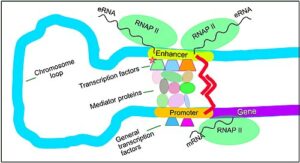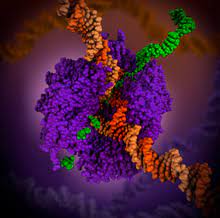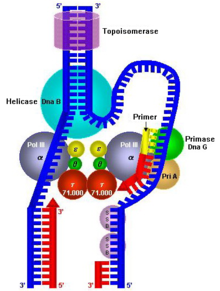The DNA is said to be material for genetic coding and is called to be a blueprint as it has many data that a cell needs.
The process of DNA Transcription is actually carried out by an RNA polymerase which makes it a DNA transcription enzyme. There are also presences of much number of accessory proteins that are factors for it. Prokaryotes use one type and the eukaryotes have three of them.
The researchers have shown that the coding in DNA can be based on two steps to get itself read. The two steps are transcription and translation. In the process of transcription, a part of the double helical structure of DNA give rise to the single stranded molecule of RNA. The polymerase of RNA is also vital for the other methods in body.
In few of the situations, the molecule of RNA is said to be the final product which is used for some cell imports. Thus, as for such reasons transcription if the molecule of RNA is then followed by the step of translation those results in the making of a molecule. It helps in making of the strands in both the nucleic acid bases.
Transcription can be said to be method that helps in copying of a segment of the DNA into RNA. The pieces of these DNA are made to transcribe into the molecules of RNA and are then copied onto the molecules of RNA that is called as non-coding RNA. Both the types of nucleic acids being DNA and RNA are made to transcribe.
Both of the two bases of RNA and DNA are used as base pairs for the nucleotides as the language of complementary base pairing. During the time of transcription, the sequence is made to read by the RNA polymerase that helps in the production of RNA strands that are anti-parallel and called the primary transcript.

DNA Transcription–Wikipedia
RNA POLYMERASE
The process of DNA transcription is used up for getting a copy of DNA that shall help in carrying of the code in next generation.
RNA polymerase being the DNA transcription enzyme along with the other ones of the basic factors needed for transcription gets to link with the promoter DNA. The helps the DNA in getting the code copied fir further succession.
It is much of a complex molecule that is made up of the subunits of proteins, the RNA polymerase helps in getting the method of transcription controlled at which the data is doted in the DNA molecule and is then copied into the new made molecule of the messenger RNA.
This DNA transcription enzyme is seen in all the species but the quantity and the composition of the proteins shall vary along with the taxa. Just for the cause, the bacteria have a single RNA polymerase type while the multicellular organism called the eukaryotes has three separate types of this enzyme. RNA polymerase I is located in the nucleolus, a specialized nuclear substructure in which ribosomal RNA (rRNA) is transcribed, processed, and assembled into ribosome.
It is a not so simple molecule composed of protein subunits. RNA polymerase helps control the transcriptional process in which data is written into a DNA molecule and then copied into a newly created messenger RNA molecule. The entire organism does need a method by which this process needs to be operated for getting the needed gene expression.
In molecular biology, RNA polymerase, or more specifically DNA-directed/dependent RNA polymerase, is an enzyme that synthesizes RNA from a DNA template. Using the enzyme helicase, RNAP locally opens the double-stranded DNA so that one strand of the exposed nucleotides can be used as a template for the synthesis of RNA, a process called transcription.

RNA polymerase is also vital for life and it on the basis of the organism the protein complex or also on the consistency of the one subunit each gets to represent a link. Prokaryotes are said to have only one of its type while the eukaryotes have three of them with each being important. The subsets are-
- RNA polymerase I help in getting the pre ribosomal RNA synthesized that matures and makes a formation of the major part of RNA of the ribosomes.
- RNA polymerase II helps in getting the precursor of the messenger RNA synthesized and mostly the sRNA and the micro RNA.
- RNA polymerase III synthesis the transcribe RNA and the ribosomal RNA that is 5S and the other entire tiny RNA see in the cytosol and the nucleus.
RNA polymerase as a DNA transcription enzyme
In many of the prokaryotes only one type of RNA polymerase is made to transcribe the rest of the arms.
This enzyme gets its core from the bacteria E.coli that have five units of two of the alpha ones and a beta and a subunit of beta prime. There is a sigma factor that gets to bond it making a holoemzyme.
After the process of transcription, this factor marks itself detached and then lets the core of the enzyme process with its work. The core of this complex makes a formation of carb claw or the clamp claw within the inside channels that runs all through the length. The eukaryotes also have this in structure. One strand of DNA, the template strand, acts as a template for RNA polymerase.
A transcription factor and its associated transcription mediator complex must be attached to a DNA binding site called a promoter region before RNAP can initiate the DNA unwinding at that position. RNAP not only initiates RNA transcription, it also guides the nucleotides into position, facilitates attachment and elongation, has intrinsic proofreading and replacement capabilities, and termination recognition capability.
As it “reads” this template one base at a time, the polymerase builds an RNA molecule out of complementary nucleotides, making a chain that grows from 5′ to 3. On having the control over the method of gene transcription it can affect the expression of the genes and thus the cell needs to adapt to the change in surrounding and is helped by special roles in the organism and then helps in maintain of the functions of cell needed or survival.

Thus the use of it is long and complex and is regulated. RNA polymerases are also essential for life and are based on the coherence of the body’s protein complexes, or single subunits, each of which is a bond. Prokaryotes have one species and eukaryotes have three species. The work of this enzyme is-
- It binds with the basic factors of transcription and then links with the promoter DN
- It helps in making of the transcription bubble that helps in separating of the two strands of the local formation of DNA; this is indeed done by getting to break the hydrogen bond of the nucleotides fixed in regard to the complementary base pairing method.
- RNA polymerase gets to add up with the nucleotides of the RNA that are complementary to the strands of the nucleotides in DNA.
- The backbone is made up of sugar and phosphate and makes the RNA backbone along with its assistance from the polymerase RNS that is formed and the RNA strand.
- There is a breakage of the bonds of hydrogen of the RNA and RDNA helix and frees itself from getting the new made RNA strand synthesized.
- If there is a presence of nucleus in the cell thus then the RNA is further processed. This shall have the possibility of having splicing, capping and polyadenylation.
- The RNA might stay inside the nucleus or can also exit at the cytoplasm via the complex of nuclear pore.
Types of RNA polymerase
All of the prokaryotes have only one type of RNA polymerase but the eukaryotes have three of them having several uses.
The types of RNA polymerase are RNA polymerase I which works for the genes of ribosomal RNA, RNA polymerase II that helps with the snRNA, the snoRNA genes and the transcribe messenger RNA and lastly RNA polymerase helps with both t and s RNA.
The prokaryotes have the similar type of RNA polymerase to help the genes transcribe. There are four of the subunits given to it being α, α’, β and β′ that include the core enzyme of polymerase. These get together and link up for transcribing all the genes and then also detangle again after the process of transcription is done.
It enables in making of the transcription bubble that enables in keeping a part of the 2 strands of the neighborhood formation of DNA; that is certainly executed via way of means of getting to interrupt the hydrogen bond of the nucleotides constant in regard to the complementary base pairing method. RNA polymerases in eukaryotes are of type polymerase for 28S, 18S and 5.8S RNA, polymerase II for wRNA and snRNA and polymerase III for /RNA, 5SRNA and scRNA.
This DNA-transcribing enzyme is present in all species, but the amount and composition of the protein varies by taxon. As for etiology, bacteria have a single type of RNA polymerase while multicellular organisms known as eukaryotes have these three distinct enzymes. It can get inside the nucleus or can also exit at the cytoplasm. Critical for DNA replication are three DNA polymerases: Polymerase α-primase, Polymerase δ, and Polymerase ε. These three polymerases function at the replication fork of the DNA strands.
RNA polymerase is essential to life, and is found in all living organisms and many viruses. Depending on the organism, a RNA polymerase can be a protein complex mostly the multi-subunit RNAP or only consist of one subunit (single-subunit RNAP, ssRNAP), each representing an independent lineage. The former is found in bacteria, archaea, and eukaryotes alike, sharing a similar core structure and mechanism.
In bacteria, RNA polymerase exists in two states. One form, known as the core enzyme, can catalyze RNA synthesis but cannot bind to the promoter target of DNA. The second form of RNA polymerase, holoenzyme, is capable of both RNA synthesis and promoter recognition. RNA is created using a process known as transcription and the second form of RNA polymerase, the holoenzyme.
Also Read:
- Does fermentation occur in the mitochondria
- Dna replication steps
- Protein synthesis process
- Plant cell mitochondria functions
- Springtail characteristics
- Lysosomes and peroxisomes
- Spiral bacteria examples
- Nucleic acid structure
- Dna transcription types
- Krebs cycle in mitochondria
I am Ankita Chattopadhyay from Kharagpur. I have completed my B. Tech in Biotechnology from Amity University Kolkata. I am a Subject Matter Expert in Biotechnology. I have been keen in writing articles and also interested in Literature with having my writing published in a Biotech website and a book respectively. Along with these, I am also a Hodophile, a Cinephile and a foodie.